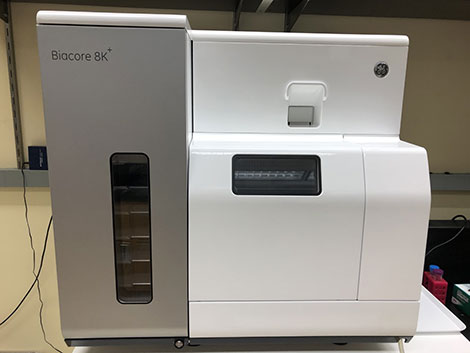Surface Plasmon Resonance (SPR) is used to monitor macromolecular interactions in real time. The Biacore systems use SPR technology for measuring the interactions of macromolecules with each other, and with small molecules. One of the molecular (ligand)is immobilized on carboxymethylated dextran over a gold surface while the second partner (analyte) flows over the immobilized ligand surface. The immobilized ligands are remarkably resilient and maintain their biological activity.
Interaction is detected via SPR, in real time, at high sensitivity, without the use of radioactivity. The bound analyte can be stripped from the immobilized ligand without affecting its activity to allow many cycles of binding and regeneration on the same immobilized surface. These instruments excel over most other methods of affinity measurements in that they are able to measure on-rates (ka in the range of 103 – 5×107M-1s-1) and off-rates (kd of 10-5 – 1 s-1).
Concentration determination experiments are also feasible. Some applications are:
- Characterization of protein-protein interactions
- Screen and selection of the best monoclonal antibodies
- Identification of potential drug targets and diagnostic markers
- Characterization of protein: small molecule interactions in drug discovery and selection of therapeutic candidates according to their on/off rates
Biacore 8K+

Unit Description
Biacore 8K+ is a state-of-the-art label-free, real-time detection system that utilizes SPR technology to study protein-protein, protein-DNA/RNA, or protein-small molecule interactions. Biacore 8K+ is a high throughput instrument that is most suitable for screening small molecule/fragment libraries and for the screening and characterization of antibodies or antibody fragments. Biacore 8K+ has been optimized for small molecule or fragment screening for binding to target proteins. Biacore 8K+ is designed for higher throughput screening and data analysis compared to Biacore T200. Biacore 8K+ is equipped with eight injection needles and 16 flow cells (8×2 configuration) vs 1 injection needle over four flow cells (1×4) on the T200, allowing up to 8x faster run-time.It hassample capacity of up to twelve 96 or 384 well plates, the ability to queue commands and methods, allowing multiple operations using the same surface to run in an automated fashion, ABA injection option, allowing collection of binding data in multiple buffer environments, or in the presence of competitor molecules from a plate of samples, a single solution for interaction analysis in both screening and characterization, reliable interaction analysis of small molecules binding to complex targets, confident differentiation of high-affinity binders and advanced and intuitive software.